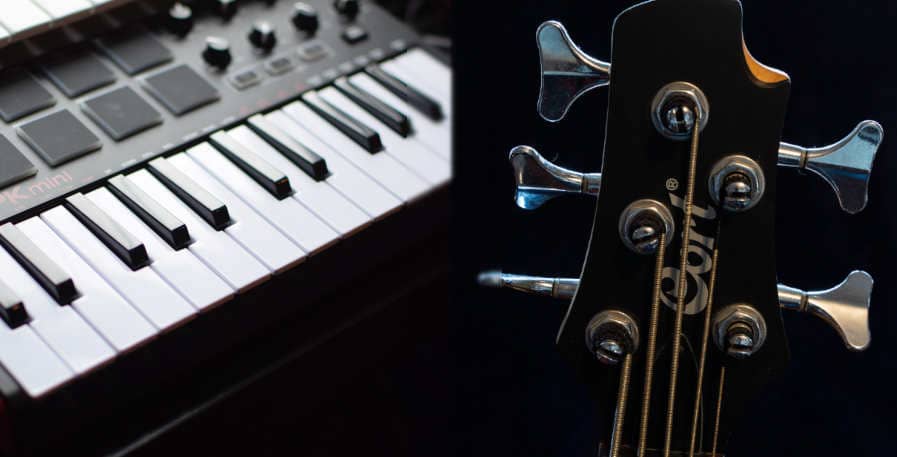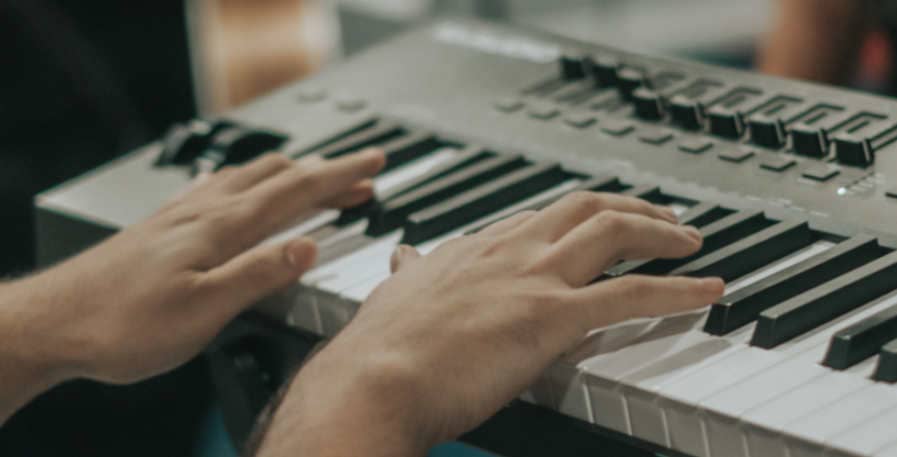The keyboard is without a doubt the most versatile instrument in modern music. So much so, that some keyboardists have experimented with the idea of using it to take on the role of other instruments. As a bass player this made me curious; can you play bass on a keyboard?
In general, a keyboard can be used to play the vast majority of bass grooves. Due to the keyboard’s vast range, it can cover the range of a bass. Furthermore, it can partly emulate the sound of a bass guitar using midi presets and sound libraries.
With that said, there are still a good bit of differences between the two instruments. Therefore, I wrote this article to clear up some misconceptions about playing bass on the keyboards.
You will learn whether the keyboards can replace the bass. Then, I will show you how the instruments differ when playing basslines. Lastly, I will show you how to play basslines on a keyboard if you are looking to give it a try.
Can a keyboard replace a bass?
Due to the deep range of a keyboard, the instrument can be used to fill the role of a bass player in a band. However, the keyboard can not perfectly recreate the sound and feel of a bass, which will result in a different type of sound.
There are many successful bands without a bassist. Among these bands are The Doors, who have sold 34 million records in the US, and more than 100 million records worldwide. The Doors did not have a bass player, but rather Ray Manzarek on the keyboards.
In modern bands where electronic elements are commonplace, it is not uncommon for keyboards to replace the bass. Some bassists, like Kevin Baird of Two Door Cinema Club, even switch between bass guitar and keyboards, depending on what fits the song best.
So at the very least, the keyboard has been used to replace the bass. Many bands have also had commercial success while doing so.
What a keyboard cannot do, is accurately replace the sound of a bass guitar.
Keyboards often have decent sound libraries with various bass guitar sounds. These can replicate the sound of a bass guitar somewhat, but due to the difference in how keys and strings are played, they will sound different.
As a result, a lot of the articulation, dynamics, feel, and groove that a bass player provides is lost. A keyboardist can provide all of this in their own way, but the two instruments will always differ in their method.

Keyboard Bass vs Bass Guitar
Thorugh the years, keyboards have started to replace the bass guitar more and more often. This is often done through the use of a Keyboard bass. This is a keyboard designed specifically to play low-frequency notes, just like the bass guitar.
This gives us a good opportunity to compare the pros and cons of basses and keyboards side by side. Here are the strengths and weaknesses of a bass and a keyboard, when they try to fill the same role:
| Keyboard Bass | Bass Guitar | |
| Composing | Great overall songwriting tool. Easier for composing chord progressions and melodies | Great for writing bass lines. Mediocre for writing chord progressions. |
| Tone | Versatile in terms of sound and tone selection. Best for a modern and varied sound | Less variation in sound, but more room for articulated and dynamic playing. Best for a human and organic sound. |
| Band role | Fills in the low end. Excels at playing sustained notes, creating soundscapes, and adjusting the sound to fit the song. | Fills in the low end. Excels at playing grooves, rock, jazz, and metal riffs, and adjusting playstyle to fit the song. |
| Low-cost entry-level instrument | $60 – $200 | $130 – $250 |
| Cost of intermediate instrument | ~$250 – $600 | ~$400 – $1000 |
| Cost of a professional instrument | $700+ | $1000+ |
| Beginner friendliness | Easy to pick up and play simple bass lines. Takes time to develop an understanding of rhythm and adjusting your tone to fit a song. | Medium level of difficulty to pick up. Possible to play simple lines at a basic level in a short amount of time. It will however take some time to develop control of the instrument. |
| Versatility | Flexible and adaptive instrument. Can be fit to work with most genres of music. | Some versatility through EQ and effects. How fit a bass is for any specific genre is partly dependent on instrument design. |
| Most common genres | Pop, Hip-Hop, R&B, House, Electronic, Indie | Pop, Rock, Metal, Jazz, Punk, Indie, Hip-Hop |
How to play basslines on a keyboard
When playing bass on a keyboard, it helps to think like a bassist. Here are 4 tips that will help you play the keyboards like a bass player, without having to pluck a single string:
- Pick a fitting sound – The biggest strength of the keyboards over the bass guitar is sound selection. When playing bass on the keyboards you should therefore always make good use of this strength. A bassline or song might need a distorted, spacy, musky, or neutral tone, and you will have them all at your disposal. Good ways to find a fitting sound are to experiment and to listen to what sounds have been used in similar songs. For some, it will help to notice how the song makes you feel, and pick a sound that reflects that feeling.
- Fluid hand movement – Keyboardists tend to play a lot of chords. Generally, chords on the bass sound muddy, and bassists thus play one note at a time. Therefore, playing bass on the keyboards requires you to rethink your hand technique. Oftentimes, you can use your hand like a seesaw and twist your wrist as you hit notes. This will be easier to do when you are not playing chords and gives you a lot of control over how you want to articulate notes.
- Listen to the drums – A good bass player will lock in with the drummer to create a tight rhythm section. Therefore, it`s really helpful for you to start paying closer attention to the drums and treat your collective sound like one instrument. Pay close attention to the bass drum in particular. In most genres, it will make sense to accent your lines at the same spots as the bass drum, or the snare drum.
- Use octaves and fifths – A simple way to play more melodic bass lines is to add octaves and fifths. If you are struggling to write keyboard parts that sound like basslines, this is a great place to start. Jumping from the root note to the 5th or octave occasionally provides a lot of groove and sounds “bassy”. This will work especially well when you have locked in with the drummer. Bass drum and snare drum hits are both great spots for adding some 5ths and octaves to make your lines sound more groovy.
Conclusion
While some other bassists dislike the idea of keyboards replacing the bass guitar, I`m all for it. The keys bring a new dimension of options for the low-end. With that comes the potential for new and amazing music.
The bass and keyboards will however never be the same. They both have their own strengths and weaknesses. Both have genres that they can shine in, while they fit poorly into others.
If you want to use the keyboards to play bass it helps to think like a bass player. Providing the low-end groove in a band requires a unique approach. This is different from the role that a keyboardist traditionally fills. This will take some adjusting to get used to, but will ultimately make you a more versatile musician.
The tips outlined above will help you get started. As you progress as a bass keyboardist, I recommend striving towards the same goals as bassists who are looking to become intermediate.
Further reading: What makes a bassist intermediate?

